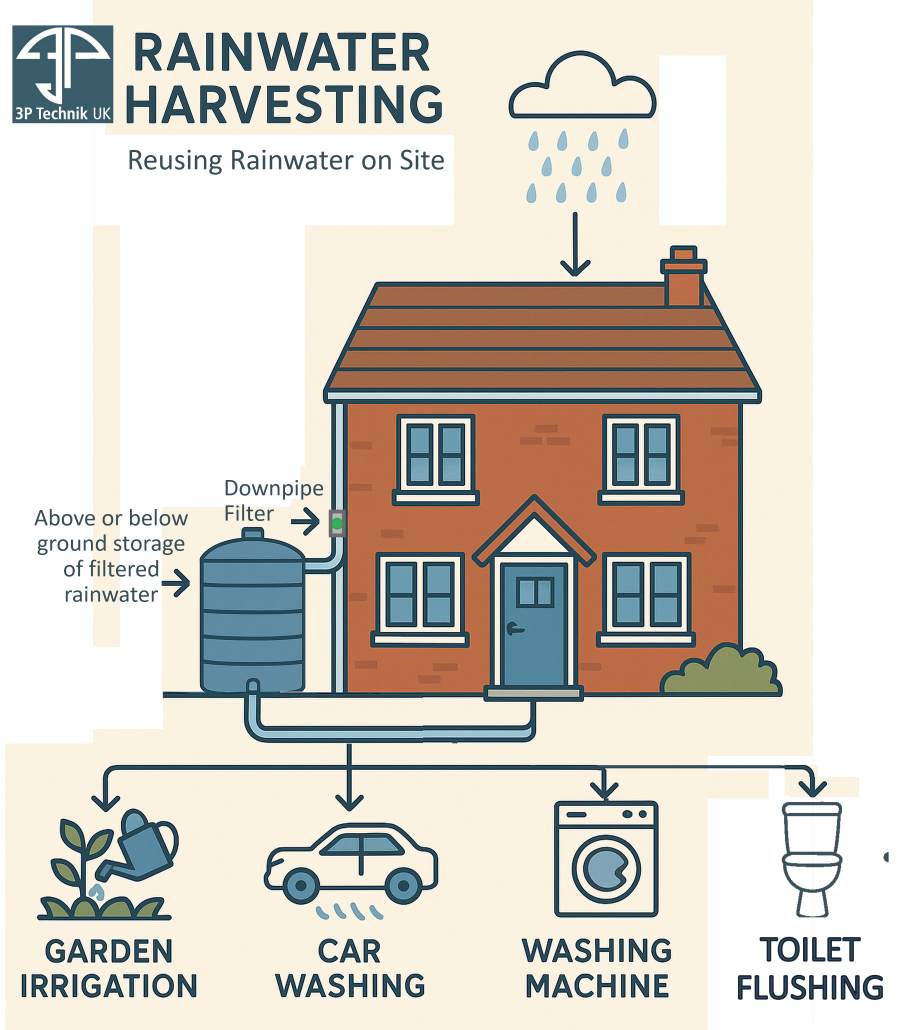As new housing estates are developed, large areas of land are converted into impermeable materials, including roads, roofs and driveways. With the growing population in the UK, the demand for housing increases, contributing to greater urbanisation.
The proportion of impermeable surfaces present in urban areas has increased from 37% in 2001 to 46% in 2022 (Climate Change Committee, 2023). These impermeable materials prevent surface water from soaking into the ground, greatly reducing natural infiltration and increasing the volume of surface water runoff. Combined with the increasing frequency and intensity of rainfall driven by climate change predicted for the UK, this creates a higher risk of flooding from surface waters, as the traditional drainage systems cannot cope with the accelerated rate of runoff.
Rainwater harvesting (RWH) simply means collecting and storing the rainwater that falls onto your roofs for later use – this offers a sustainable solution to excess runoff on your land.

Uses of rainwater within SuDS
Benefits of rainwater harvesting
Water being captured and stored on site in water tanks or water butts for reuse means that the volume of surface water entering drains decreases. This reduction in runoff (slowing the flow) lessens the pressure on local drainage systems during rainfall and delays peak discharge rates; therefore, the likelihood of flooding on site and downstream in the wider catchment is reduced.
The use of RWH within Sustainable Drainage Systems (SuDS)
The use of a Sustainable Drainage System (SuDS) is to aid in reducing flood risk while improving water quality and biodiversity. In Wales, new housing estates are required to comply with Statutory SuDS regulations under Schedule 3 Flood and Water Management Act 2010 and must meet all six standards to begin construction. In England, SuDS features are guidance, and new developments are encouraged to implement them into their construction design, despite not being a legal framework.
Both England and Wales SuDS standards contain the Hierarchy standard (Standard 1), which prioritises reusing surface water on site and as close to its source as possible, before allowing it to downgrade in priority levels (reuse, infiltration, discharged to above-ground surface water body, discharges to piped system, discharged to combined sewer). Incorporating rainwater harvesting within a SuDS plan follows this hierarchy standard to its highest priority level.
By having effective SuDS on your land, it makes the property more environmentally friendly and economically valuable. It also prevents flooding on the property to an extent, which will be valuable during high rainfall periods or storms to delay the flow of surface water runoff.
Additional benefits of rainwater harvesting
- Water security: Stored rainwater provides a secondary water source on your property; therefore, you have access to water during summer months or dry spells.
- Reusing rainwater: This water can be treated by simple filtration to be used to irrigate your garden, wash cars, flush toilets and wash laundry.
- Cost savings: After the initial installation for rainwater harvesting, the free water you collect will help cut costs from your mains water bill, easing the high-water demand and high pressure on the shared mains water system.
- Environmental benefits: Dependence on main water is reduced; therefore, energy that is used for water treatment and distribution (pumps) is conserved
Overall, harvesting rainwater is a low-tech system with high impact on the local environment, and by harvesting a valuable free resource, it prevents a hazard from occurring. Rainwater harvesting conserves water, supports flood protection and promotes sustainable, climate-resilient housing developments.
At 3P Technik we are always happy to review and discuss rainwater harvesting products and water quality treatment designs. Our suite of devices can be used either on their own or in a treatment train with green infrastructure. Contact us with your requirements.
